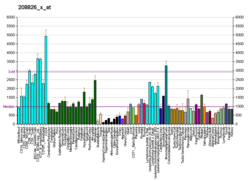| HINT1 | |||||||||||||||||||||||||||||||||||||||||||||||||||
|---|---|---|---|---|---|---|---|---|---|---|---|---|---|---|---|---|---|---|---|---|---|---|---|---|---|---|---|---|---|---|---|---|---|---|---|---|---|---|---|---|---|---|---|---|---|---|---|---|---|---|---|
 | |||||||||||||||||||||||||||||||||||||||||||||||||||
| |||||||||||||||||||||||||||||||||||||||||||||||||||
| Identifiers | |||||||||||||||||||||||||||||||||||||||||||||||||||
| Aliases | HINT1 , HINT, NMAN, PKCI-1, PRKCNH1, histidine triad nucleotide binding protein 1 | ||||||||||||||||||||||||||||||||||||||||||||||||||
| External IDs | OMIM: 601314; MGI: 1321133; HomoloGene: 3904; GeneCards: HINT1; OMA:HINT1 - orthologs | ||||||||||||||||||||||||||||||||||||||||||||||||||
| |||||||||||||||||||||||||||||||||||||||||||||||||||
| |||||||||||||||||||||||||||||||||||||||||||||||||||
| |||||||||||||||||||||||||||||||||||||||||||||||||||
| |||||||||||||||||||||||||||||||||||||||||||||||||||
| |||||||||||||||||||||||||||||||||||||||||||||||||||
| Wikidata | |||||||||||||||||||||||||||||||||||||||||||||||||||
| |||||||||||||||||||||||||||||||||||||||||||||||||||
Histidine triad nucleotide-binding protein 1 also known as adenosine 5'-monophosphoramidase is an enzyme that in humans is encoded by the HINT1 gene. [5] [6]
HINT1 hydrolyzes purine nucleotide phosphoramidates with a single phosphate group. [7] In addition, functions as scaffolding protein that modulates transcriptional activation. [8]
It is a haploinsufficient tumor suppressor gene that inhibits the Wnt/β-catenin pathway in colon cancer cells and microphthalmia-associated transcription factor (MITF) activity in human mast cells. [9] [10] In the LysRS-Ap4A-MITF signaling pathway, HINT1 inhibits the MITF transcriptional activity by direct association. Upon pathway activation, HINT1 is released from MITF by diadenosine tetraphosphate (Ap4A), produced by LysRS. [10] [11]

















